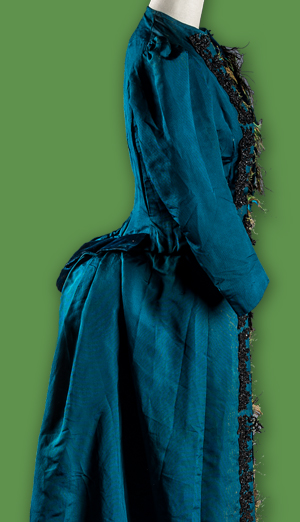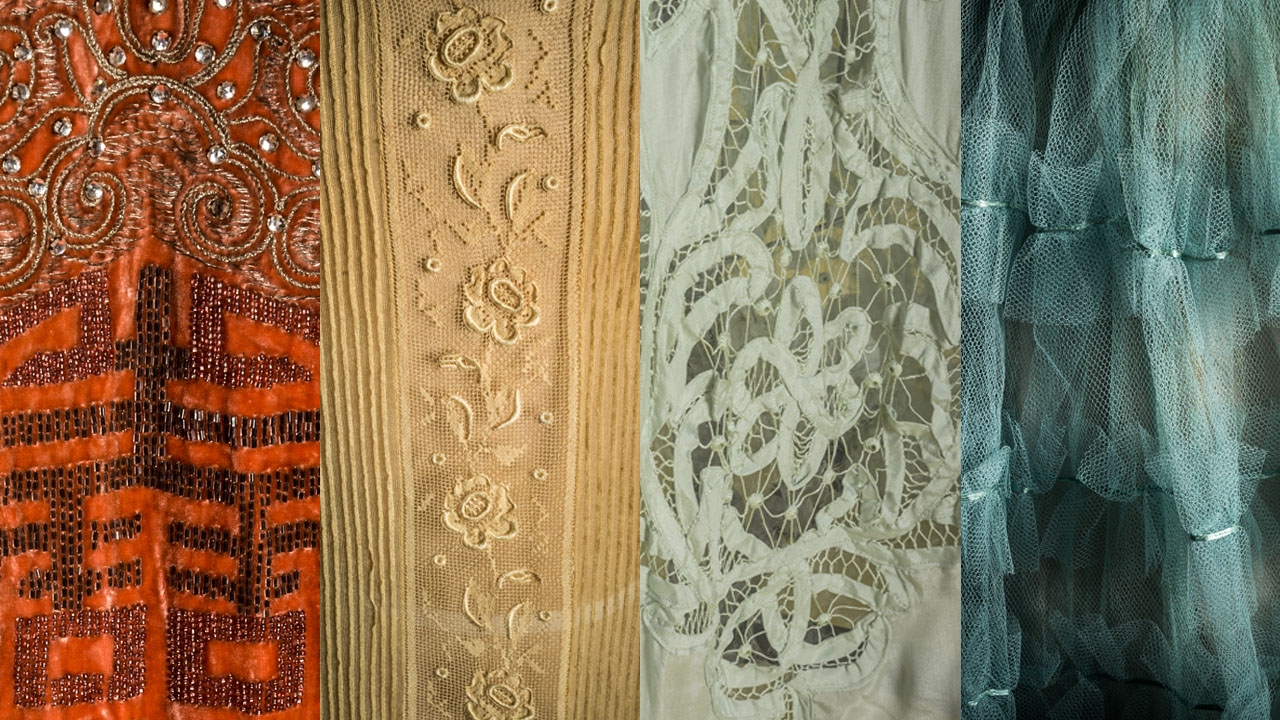Even after 130 years, the rich blue skirt and bodice, trimmed with iridescent peacock feathers, has the power to make you feel a tad underdressed.
 Rhapsody in blue: Page and Mattes list this 1880s skirt and bodice, made from silk taffeta and trimmed with peacock feathers, among their favorite pieces in the vintage clothing collection.
Rhapsody in blue: Page and Mattes list this 1880s skirt and bodice, made from silk taffeta and trimmed with peacock feathers, among their favorite pieces in the vintage clothing collection. It’s an imposing, slim-waisted ensemble, retaining all the intensity and formality sewn into it in the 1880s. “These garments were worn by someone who likely didn’t dress herself—she had help from a servant or family member,” explains Amy Page, M.F.A., UAB assistant professor of theatre and costume director. For proof, she points to the complicated fasteners and the luxurious but fragile silk taffeta that cascades from the neck to the floor via the bustle. The little-worn condition of that fabric hints that “this individual also had several sets of clothing for each day—she would change for breakfast, for visiting, for hosting, and so on.”
Page and her UAB Costume Shop colleagues have been following a lot of historical threads lately. Last fall, a local vintage-clothing collector, preparing for a move, graciously donated more than 200 pieces to the Department of Theatre—rack upon rack of dresses, skirts, bodices, hats, gloves, shoes, parasols, fans, a few men’s garments, sporting equipment, and, of course, the blue silk-peacock suit. All together, the collection showcases 90 years of changing fashions, from the 1880s to the 1970s. Page calls the scope of the gift one of the biggest surprises of her career and a “treasure trove of history”—one that UAB theatre students will be able to mine for information and inspiration.
Lessons from a Dress
So what knowledge can an opulent, rhinestone-dotted cloak from 1910s Paris or a flirty, emerald-green 1950s dress impart?
“We can see how garments were made, the materials that were used, and the role that clothing played in different eras,” says Kimberly Schnormeier, M.F.A., associate professor of theatre and associate dean for academic advising in the College of Arts and Sciences, who teaches courses in costume design and costume history. “For example, students can understand how restrictive Victorian clothing was and the liberation women must have felt in the 1920s when they shed their corsets and layers of petticoats. Looking at garments from a particular era offers a sense of how they looked on a normal person, as opposed to an idealized figure in a fashion illustration.”
Something as simple as stitching—whether clothing was sewn by hand or machine—“can tell you a lot about someone’s taste, their socioeconomic background, and even bits of their everyday life,” says Amanda Mattes. As interim manager of the Costume Shop, where students create all the costumes used in Theatre UAB’s four annual productions and its Festival of Ten-Minute Plays, Mattes says the vintage collection will be a popular reference. Studying these garments and their history can help a “costume designer make decisions for the characters in a production, based on what is written in the script about them and the characterization each actor is using,” she says.
For the February 2015 production of Sarah Ruhl’s In the Next Room (or The Vibrator Play), set in the 1880s, “we could pull a bodice from this time period and discuss seam lines,” says Page, who leads courses in costume construction, pattern development, and theatre crafts. “I can tell students about this or recommend a million resources, but it’s a whole different experience to show them the actual garment. They get to make their own observations and develop their patterns from there. They’re more inspired when it’s real life.”

Hat Tricks
Because the vintage clothes are fragile, audiences are not likely to see a student actor sporting them on stage. Some could be reproduced, however—with a few key design alterations. “We evaluate the historical structure and use historical patterns as a starting point,” Page says. “But productions often call for actors to move in ways that people in history may not have done, so we have to make compromises. For example, we would adjust the shape of 1880s sleeves to allow for more movement.” Fabrics for theatre are more substantial as well; a costume must withstand the run of a show and be available for future productions. “And if we’re working on a production set in a time before the sewing machine, we’re not going to hand-sew all the clothes together,” she laughs.
 Fashionable and functional: A 1950s Dior "New Look" hat conceals an intricate structure to help it stay on the wearer's head.
Fashionable and functional: A 1950s Dior "New Look" hat conceals an intricate structure to help it stay on the wearer's head.Along with historical accuracy and aesthetic direction, the garments provide students with practical lessons. The donation includes at least 50 hats—in all kinds of whimsical shapes, topped with feathers, giant bows, or stylized felt birds. But “how the hats functioned is the most interesting aspect,” Page says. “A lot of them have intricate wire structures. We’re working on fascinators [decorative headwear] now, and I’ve shown students examples from the collection that have smart solutions for keeping the hat snug on the head.” That kind of knowledge can be valuable for a variety of career fields, from theatre, opera, ballet, and other performing arts to fashion design.
Not-So-Fast Fashion
The vintage garments also have something to say about today’s world, Page notes. “As a society, we don’t have much connection to what it takes to make a garment, because a lot of the garment industry has moved overseas,” she says. Some students arrive on the first day of class not knowing how to thread a needle. Page helps them cultivate their hand skills, and by the end of the semester, those students have constructed a garment.
Even the more senior students, who use sewing machines, are taken aback when they see, for example, the elaborate lacework that adorns the collection’s Edwardian silk day dress. “It’s nice to show them where we came from,” Page says. “It started with someone sitting there, hand-stitching every detail.
“It brings students a little more into reality,” she adds. Studying historic garments and making new ones helps them understand how times have changed, and the difference in quality between the Edwardian dress and the $30 jackets they can buy today. If a button pops off that jacket, “they won’t get upset because they realize it was sewn by someone in a factory getting paid by the number of pieces they can produce in a day,” Page says. Plus they’ll have the skills to sew the button back on, she adds.

Vintage in Vogue
The donated garments help place UAB’s theatre department in a national spotlight, Mattes says. “Offhand, I can think of maybe three university theatre departments that have a full collection of vintage pieces, and those took years to acquire,” she says. The garments, along with pieces given to the Costume Shop by other donors in the past, could prove to be a draw for students considering a theatre education at UAB. In a recent costume workshop for high-school students, the elaborate vintage wear immediately caught their eyes.
“It was fun to show them things they had never seen before,” Page says. “They had a chance to learn a little bit about history.”
Now the Costume Shop is working to preserve its new treasures by storing the fragile garments away from bright light, in a climate-controlled environment. Padded hangers, acid-free archival boxes, tissue, and batting will help prevent fabric deterioration.
But Page doesn’t think the garments will stay in the dark for long. The vintage collection offers “endless opportunities” to teach students, and she hopes that they experience wonder and surprise, just as she did when she met the donor and saw the pieces for the first time. “It’s always special when you recognize in someone else a love for something you both share,” she says.
 Stitches in time: The intricate stitching and quality of the work inside the blue skirt and bodice can shed light on its history.
Stitches in time: The intricate stitching and quality of the work inside the blue skirt and bodice can shed light on its history.
Stories in the Seams
Styles, silhouettes, and even color combinations can offer hints about the era when a garment was made, but sometimes looks are deceiving, says Mattes. “Some people altered their garments, or added trims, in other decades. When there wasn’t a lot of money for a new dress, such as during the Great Depression, you might take a dress from the ’20s and embroider it with a more ‘modern’ motif.”
It turns out that dating garments accurately requires plenty of detective work—and archaeology. “We conduct research on a regular basis, and some of the most interesting information we receive about vintage clothing comes from the interior of the garment,” Page explains. Hand or machine stitching—and the quality of the craftsmanship—can help reveal when a piece was made and whether it was sewn at home, by a tailor, or in a factory. The lining often provides another peek at history, Page says. “Was the lining left over from something else—perhaps an older dress? Are the interior seams hand-stitched, covered in lace, or bound?”
Clothing tags can help identify the origin of a piece, but “it was not uncommon for designer labels to be placed in garments not made by the designer,” Schnormeier says. “The appropriate research must be done to verify authenticity.”
Adornments, trims, and types of closures offer further clues, along with fabric choice. “Many synthetics weren’t in popular use until the 1930s and ’40s,” Mattes says. But the most surprising change in clothing over the decades may be their sizes, she adds, considering the items in the vintage collection. “Most of these clothes fit very small women, so it’s interesting to see how the population has grown, physically, in modern times.”



